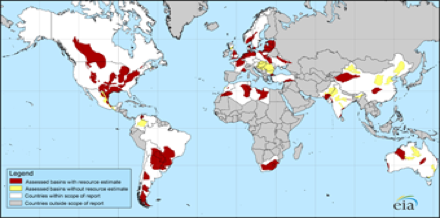Technically Recoverable Shale Gas Resources Jump 134 Percent
The Energy Information Administration’s estimates of technically recoverable shale gas resources have jumped 134 percent in one year. In the Annual Energy Outlook 2010, technically recoverable shale gas resources were estimated to be 368 trillion cubic feet. In the Annual Energy Outlook 2011, the estimate shot up to 862 trillion cubic feet. The increase in shale gas brings total U.S. recoverable natural gas resources to 2,629 trillion cubic feet. This is a welcome change because as little as 10 years ago, analysts and politicians said that the United States could not drill its way out of a natural gas shortage. [i]But, with new technology and investment, we did just that.
The huge increase in shale gas technically recoverable resources is due to the extraction technique: hydraulic fracturing in conjunction with horizontal drilling that allows the capture of much more natural gas than using conventional drilling techniques. With hydraulic fracturing, water, sand and gels are injected into the well to break up the shale rock. And then, horizontal drilling is used to capture the gas from the fractured shale rock. Shale gas resources are found in many areas in the lower 48 states, but the largest formations being drilled today are the Barnett in Texas; the Marcellus that extends from southern New York, across Pennsylvania, and into western Maryland, West Virginia, and eastern Ohio; the Fayetteville in Arkansas; and the Haynesville in Louisiana.
According to the Energy information Administration (EIA), shale gas produced 2.3 trillion cubic feet of natural gas in 2008, an 11 percent share, and it is expected to produce 12.3 trillion cubic feet by 2035, a 47 percent share of the natural gas market, with production growing at over 5 percent per year. Domestic shale gas production has turned the U.S. natural gas import market around. The U.S. had thought it needed to build re-gasification terminals to re-gasify imported liquefied natural gas (LNG) from abroad, including the Middle East, to compensate for lower domestic production and declining pipeline imports from Canada. Instead, natural gas production, estimated growing at an annual rate of 0.9 percent a year through 2035, is compensating for lower pipeline and LNG imports and meeting expanding demand.
World Shale Gas Resources
U.S. shale gas resources are the second largest in the world, according to a study that EIA commissioned with ARI International, covering the shale gas resources of 32 countries and 14 regions. China has the largest shale gas resources of the 32 countries reviewed at 1,275 trillion cubic feet. After the United States, Argentina ranks third with 774 trillion cubic feet, Mexico ranks fourth with 681 trillion cubic feet, Australia fifth with 396 trillion cubic feet, and Canada sixth with 388 trillion cubic feet.
The graph below depicts the areas and resources assessed. The white areas are those covered by the study; the red areas are those for which resources estimates were made. The assessed world shale gas technically recoverable resources total 6,622 trillion cubic feet, slightly more than the world’s natural gas proven reserves of 6,609 trillion cubic feet. Reserves of gas are those deposits that are known to exist and are readily producible at current prices. They are a subset of the technically recoverable resource base. The technically recoverable resource base includes reserves, inferred natural gas, and undiscovered gas that can technically be produced using existing technology. These world shale gas estimates are uncertain given the relatively sparse data that currently exist. Because of the methodology used to determine the estimates, they represent a lower bound on the shale gas resources of the assessed areas.
The countries assessed were selected because they either were candidates for importing LNG, or because they are believed to have fairly large shale gas resources.
Countries and Regions Assessed in the Study
[table id=38 /]
Sources:
1Dry production and consumption: EIA, International Energy Statistics, as of March 8, 2011.
2 Proved gas reserves: Oil and Gas Journal, Dec., 6, 2010, P. 46-49.
3Romania, Hungary, Bulgaria.
4U.S. data are from various EIA sources.
Conclusion
Hydraulic fracturing and horizontal drilling technology has brought about a welcome change to the natural gas market with large supplies and low prices. Just 10 years ago, analysts and politicians were saying that the United States could not drill its way out of a natural gas shortage. But, with new technology and investment, the U.S. oil and gas industry accomplished what was believed unlikely a decade ago.
Shale gas has made the United States practically free of imported natural gas. In 2008, on net, the U.S. imported 13 percent of its natural gas supply. That share is expected to fall to less than 1 percent by 2035, according to the EIA’s Annual Energy Outlook 2011. And not only are natural gas imports affected, but U.S. natural gas prices at the wellhead dropped by 54 percent between 2008 and 2009.
If only our government would let us try innovative technologies to produce shale oil on Federal lands in Colorado, Utah, and Wyoming, the same success story could happen again.
[i] Inside F.E.R.C.’s Gas Market Report, May 24, 2002, LOW PRODUCTION SUBSTANTIATES BULLS, BUT HIGH STORAGE, HYDRO BACK BEARS, and Platt’s Oilgram News, May 16, 2001, RIVAL US ENERGY PLAN BACKS SPR RELEASE




